
Boana is a genus of frogs in the family Hylidae. They are commonly known as gladiator frogs, gladiator treefrogs or Wagler Neotropical treefrogs. These frogs are distributed in the tropical Central and South America from Nicaragua to Argentina, as well as in the Caribbean.

The white-edged tree frog is a species of frog in the taxonomic family Hylidae endemic to Brazil.

The Demerara Falls tree frog is a species of frog in the family Hylidae found in Bolivia, Brazil, Colombia, Ecuador, French Guiana, Guyana, Peru, Suriname, and Venezuela. Its natural habitats are subtropical or tropical moist lowland forests, subtropical or tropical swamps, rivers, freshwater marshes, intermittent freshwater marshes, rural gardens, and heavily degraded former forests.
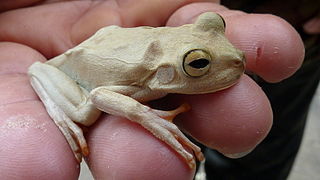
The emerald-eyed tree frog is a species of frog in the family Hylidae. It is largely restricted to the Atlantic Forest region of Brazil. Some populations previously regarded as Boana crepitans have been separated into the species Boana xerophylla and Boana platanera.

The Amapa tree frog is a species of frog in the family Hylidae found in northern Brazil in the Amapá state, French Guiana, and southeastern Suriname. It belongs to the Boana albopunctata species group.

Boana xerophylla is a species of frog in the family Hylidae. It is found in northern Brazil, French Guiana, Guyana, Suriname, and Venezuela south of the Orinoco.
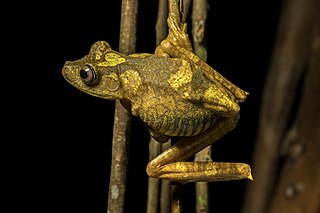
The map tree frog is a species of frog in the family Hylidae found in Bolivia, Brazil, Colombia, Ecuador, French Guiana, Guyana, Peru, Suriname, Trinidad and Tobago, and Venezuela. Its natural habitats are subtropical or tropical dry forests, subtropical or tropical moist lowland forests, moist savanna, subtropical or tropical seasonally wet or flooded lowland grassland, rivers, freshwater lakes, intermittent freshwater lakes, freshwater marshes, plantations, rural gardens, heavily degraded former forests, ponds, and aquaculture ponds. It was previously known as Hyla geographica. The name comes from the reticulated map-like patterns on its eyelids (palpebrum). The black tadpoles congregate in dense clusters in ponds or other calm waters.
Boana latistriata is a species of frog in the family Hylidae. It is endemic to Brazil and only known from its type locality, Itatiaia National Park, and from Marmelópolis, both in the state of Minas Gerais. The specific name latistriata refers to the wide stripes on the back of this frog.

The many-banded tree frog is a species of frog in the family Hylidae found in Brazil, French Guiana, Guyana, Suriname, and Venezuela. Its natural habitats are subtropical or tropical dry forests, subtropical or tropical moist lowland forests, moist savanna, rivers, freshwater lakes, freshwater marshes, pastureland, rural gardens, heavily degraded former forests, and canals and ditches.

The ornate tree frog is a species of frogs in the family Hylidae found in Brazil, Colombia, French Guiana, Guyana, Suriname, and Venezuela. Its natural habitats are subtropical or tropical moist lowland forests, freshwater marshes, and intermittent freshwater marshes.
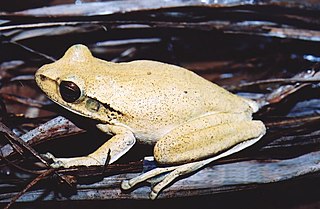
The Chaco tree frog is a frog species in the family Hylidae found in Argentina, Bolivia, Brazil, Colombia, French Guiana, Paraguay, and Venezuela.
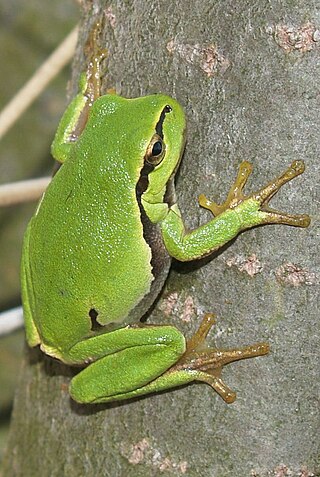
Hylinae is a large subfamily of "tree frogs", family Hylidae.

Boana platanera, commonly known as the banana tree dwelling frog, is a species of tree frog in the family Hylidae. It is distributed within Venezuela, Colombia, Panama, and Trinidad and Tobago. Boana platanera was described in 2021, and individuals of the species were previously classified as Boana crepitans or Boana xerophylla.
Boana nigra, the black-flanked tree frog, is a frog in the family Hylidae. It is endemic to Ecuador. Scientists have seen it between 910 and 1847 meters above sea level.
Boana poaju is a frog in the family Hylidae. It is endemic to Brazil.
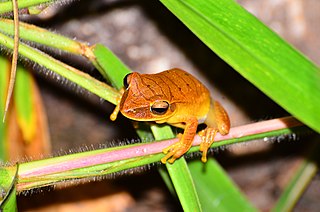
Boana paranaiba is a frog in the family Hylidae. It is endemic to Brazil.
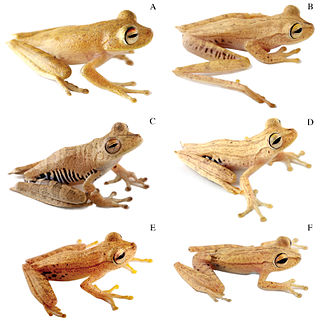
The stained tree frog is a frog in the family Hylidae endemic to Ecuador, Colombia, and Peru. Scientists have seen it between 186 and 354 meters above sea level.
Boana bandeirantes is a frog in the family Hylidae, endemic to Brazil. Scientists have seen it only over 400 meters above sea level.
Boana aguilari is a frog in the family Hylidae, endemic to Peru. Scientists have seen it between 1225 and 2080 meters above sea level.
The tepui tree frog is a frog in the family Hylidae, endemic to Brazil and Venezuela. Scientists have seen it between 420 and 1800 meters above sea level.














